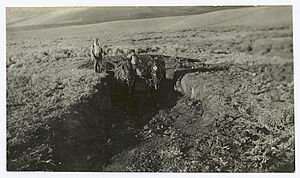Coal mining in Colorado facts for kids
Early coal mining in Colorado has a long history, starting in many different parts of the state. Some places where coal was mined a long time ago, like the Denver Basin and Raton Basin areas near the Front Range, are not active anymore. Today, there are 11 active coal mines in Colorado, and all of them are located in the western part of the state.
History
Coal mining in Colorado began way back in 1859. That's when two men started digging for coal between the towns of Denver and Boulder, which were growing fast because of the gold rush.
Miners' Struggles
The early days of coal mining in Colorado were tough for the miners. They often faced dangerous working conditions, and many people were hurt or even died in the mines. For example, in 1917, 121 people died in the Hastings mine explosion.
Miners wanted safer conditions and better pay. To achieve this, they started forming groups called labor unions. These unions helped workers speak up together for their rights. The town of Erie, Colorado claims to have the first mining labor union in Colorado. It was called the Knights of Labor, Local #771, and it started in 1878. This union called its first strike in 1885. A strike is when workers stop working to demand changes.
Another important union was the United Mine Workers (UMW). Sometimes, companies hired people to secretly watch the unions and report back. These were called "company spies." This made it harder for the unions to succeed in some early strikes, like one in 1903-04.
The UMW called another strike in northern Colorado in 1910. This strike helped miners get a 10 percent pay raise. The union also wanted to help miners in the larger southern coal fields, south of Pueblo. A big statewide strike in September 1913 led to a very sad event known as the Ludlow Massacre. After this event, federal troops were sent in, and the UMW stopped most of its activities in Colorado for over ten years.
In 1927, Colorado coal miners went on strike again, this time with a different union called the Industrial Workers of the World (IWW). A large company named Colorado Fuel and Iron, which owned steel mills and coal mines, was against this strike. They also hired spies to find out what the union was planning.
The 1927–28 strike is remembered for another serious event called the Columbine Mine massacre. However, this strike also led to an important change. The Rocky Mountain Fuel Company decided to allow its workers to join a union. Its president, Josephine Roche, announced that she would recognize any union connected to the American Federation of Labor. This helped the United Mine Workers get their first contract in Colorado in 1928.
Finally, in 1933, new laws were passed that made it easier for workers to form unions throughout Colorado's coal fields.
Current Coal Production
Colorado is one of the top ten states in the country for producing coal. In 2014, mines in Colorado produced about 21.8 million metric tons of coal. About 2,069 miners worked in these mines. Most of the coal mined in Colorado is used to generate electricity.
Today, there are eleven active coal mines in Colorado. Eight of these are underground mines located in different counties like Delta, Garfield, Gunnison, La Plata, Rio Blanco, and Routt. The other three are surface mines in Moffat and Montrose counties. All of these active mines are on the western side of the state.
In 2015, coal was used to create 31 TWh (terawatt-hours) of electricity in Colorado. For comparison, natural gas provided 12 TWh, and wind power made 7 TWh.


